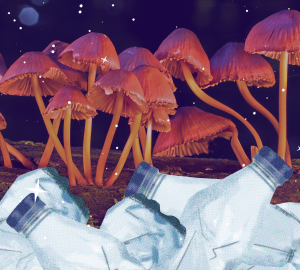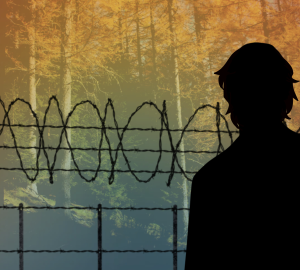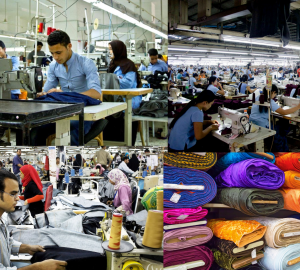By Kate Marie Phillips
“Open Your Eyes” is a bimonthly column seeking to expand our realm of awareness beyond the everyday tunnel-vision perspective—to encourage readers to more consistently notice the often-overlooked social and environmental impacts we have upon the world and find ways of reforming our day-to-day lives to evolve into more conscientious human beings.

Processing page 19 out of 25: the printer blinks. Congratulations, you’ve successfully contributed to global deforestation, excessive water usage, corporate waste, and air pollution. But what if there is some alternative material? Or a way to use less material? Will you do your part? And what are the ways of doing so?
Take a quick mental snapshot of your own life. Check out your closet. Consider your art supplies. Take into account your other basic dorm/apartment products, such as laundry detergent, silverware, bedding, carpets, etc., as well as the food in your kitchen and your hygienic products. Start a checklist with a few, basic questions. For example: what materials went into the actual products—are they sustainable? Who were the people who actually made them, and were they treated fairly? Also, what type of energy produced the product and what were the byproducts?
Following the simple, eco-friendly ideology of “reduce, reuse, recycle,” these products can be can be addressed in a systematic light, and reducing your ecological footprint can be accomplished. To begin your journey, here is a collection of pointers to become a smarter consumer while limiting your consumption. For more information on any of the products, people, or services listed below, simply click the green hyperlinks provided.
Simple solution 1: Reduce consumption of paper
Double-check your print settings before you finalize. Verify the print job is linked to the right printer, especially if you are on the third floor of Building A. If you’re not paying attention, you may mistakenly print a job that doesn’t require color accuracy to the color printer, therefore wasting higher quality ink and paper. Moreover, if your printing job doesn’t require full-page placement, try increasing the number under the “Pages Per Sheet” drop-down section from “One Page Per Sheet” to “Two Pages Per Sheet” for jobs that include text like Word documents and articles. Though smaller, the text will still be readable, but each page will now print side by side on a landscape-oriented sheet rather than placed portrait-style. For images necessary only for quick reference, you have the ability to increase the pages per sheet beyond two per sheet to create handy thumbnail papers. An additional paper-saving idea is to select the double-sided option which will cut your paper usage in half — literally. For a visual explanation, click here.
Simple solution 2: Try new eco-friendly art products
SCAD students have begun dabbling into some already; recycled drawing paper being the most often observed. These products are marketed most popularly by Canson and Strathmore. Wind-powered sketch pads are also available by Strathmore.
Despite these products moving in a positive direction, they continue to utilize extreme amounts of water. An innovative new product has been invented, however, in hopes to phase out all tree-derived papers. The product is TerraSkin. As self-described by the company, “Terraskin is a combination of mineral powder … and a small quantity … of non-toxic resin combined to create an environmentally friendly paper … requir[ing] no water … [or] trees. Used TerraSkin paper will start to degrade under … high heat, moisture and UV light. Because the paper is fiber-less, it does not absorb ink like regular paper … us[ing] less ink … Images stay much crisper and cleaner because the ink doesn’t bleed.” SCAD Students have begun to use this already, most notably in the mass production of JCPenney Shopping bags by Industrial Design students Stephanie Farah, Ana de Leon, Alejandro Figuerdo, and Tatiana Lara.
Simple Solution 3: Use everyday products made with eco-friendly materials by sustainable processes
Many companies are adding “green” to their profiles, but some stick out from the crowd more than others. Consider switching the cereal in your morning routine to one of Mom’s Best Naturals’ mouthwatering breakfast products. Their company reduces their ecological footprint by using energy obtained 100 percent by wind power and recycling 95 percent of their waste at their plants, as a part of their commitment to sustainability. To calculate your own footprint, click http://www.carbonfootprint.com/individuals.html.
Also, try Stonyfield Organic, a dairy company advertising the importance to “Know your food from farm to fridge.” In other words: know where your food has been cultivated, with what chemicals (or lack, thereof), if it was genetically modified, who the people are who grew it, and how it was transported to the grocery store. Besides advocating this food awareness, the company sets aside 10 percent of their earning with their Profits for the Planet Program, which dedicates funds toward protecting and restoring the earth.
Stonyfield, Mom’s Best, and many other similar companies provide printable coupons online for their products for those who are pinching pennies. There are tips and tricks to make eating these types of food more affordable. For instance, transfer the money spent on fast food to organic. Then pack lunches with that new, fresh food instead of eating out. It can take the same amount of time to idle in a drive-thru as it would to throw together a healthy meal to go. For more reasons to go organic, click here. For shopping tips, click here.
As far as non-edible products go, Honda and Toyota are making leaps and bounds toward more-energy efficient transportation that is better accessible and sustainable. The are accomplishing this by reinventing ways to “fuel” transportation through alternatives such as the hydrogen cell and electricity. Charging stations and alternative fuel providers are blossoming across the country for these hybrids, with many publicly available in Atlanta.
The Burt’s Bees company is also dedicated to having a 100 percent socially- and environmentally-engaged workforce as well as 100 percent natural products packaged in 100 percent post-consumer-recycled materials. Moreover, their goal is to produce zero waste via 100 percent energy efficient buildings. All of these goals are projected to be achieved by 2020 in an effort to keep the world looking beautiful, just like you.
Simple Solution 4: Donate your used items for reuse and find recycling near you
What once was fashionable to you, now is not. Or, maybe it simply does not fit anymore. Donate. How about those unwanted books, pots and pans, furniture, and DVDs? Donate. Where, you ask? For clothes in Atlanta, there are many donation bins available nearby, often in shopping centers and gas station parking lots: in the Texaco next to Ted’s, less than a mile north of SCAD on Peachtree Street, as well as in the Walmart parking lot on Howell Mill. Keep your eyes open. For other items, you may drop them off at thrift stores and donation centers, such as Goodwill and the Salvation Army. These centers can even provide home pickup for items. No matter where you find yourself, you can always locate a place to recycle or donate. Check out Earth911.com for recycling near you.
Simple Solution 5: Educate yourself further
There is a plethora of ways to become more eco-conscious. As an artist, there are some examples to consider, like the devastatingly informative “Running the Numbers I and II” photographs by Chris Jordan, which visually depicts the impact, through statistics, of both American and global mass culture. For example, one of his most eye-opening pieces looks beautiful from afar, but upon zooming in, you begin to recognize the forms of plastic beverage bottles — two million to be exact. This number, based upon statistics, is the amount used in the United States, every five minutes. Another of his works, “Midway”, exemplifies just one way that that these numbers — specifically the use, and littering of plastic bottles — are tragically effecting a species located over 2,000 miles from the nearest continent.
Recommended, as well, is the book Collapse by Jared Diamond, which delves into the connections between the environment and society historically and in the modern day. The book is about, as Diamond explains, “Societal collapses involving an environmental component, and in some cases also contributions of climate change, hostile neighbors, and trade partners, plus questions of societal responses.” Diamond intended that the readers of Collapse should compare modern society with history to understand the direction we may be headed into the future if our lifestyles continue the way they stand today. This book is a stepping stone for those who may not claim to care for the environment, who need more information to become ecologically-minded, or who simply want to learn more — because it scientifically educates readers as to why humanity can only be as great as the world it lives in.
Keep searching — gaining knowledge and experience will lead to even more understanding, and, soon enough, you’ll be sharing these ideas with your friends, who’ll share with their friends who’ll become inspired.



























